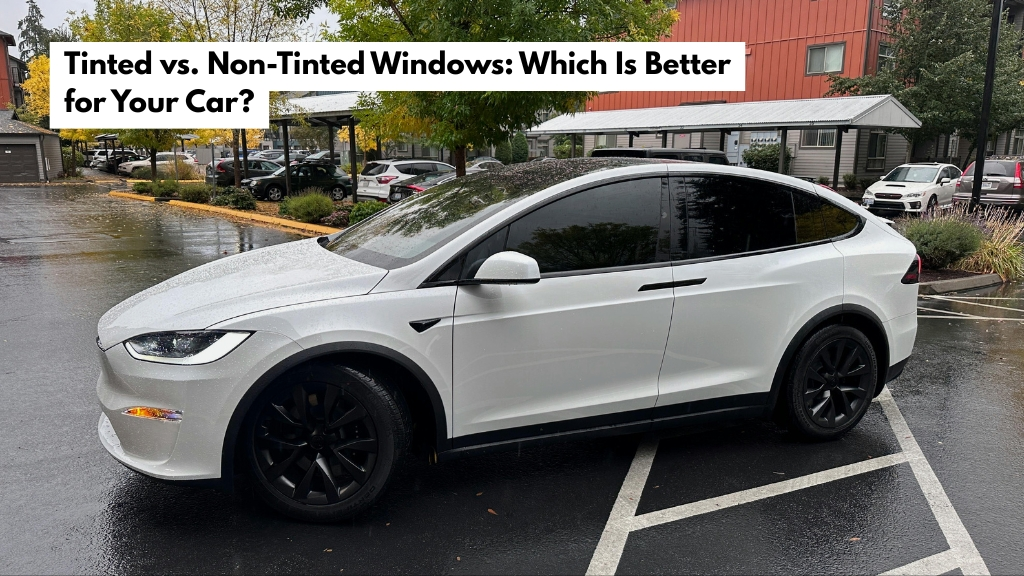
When it comes to choosing between tinted vs. non-tinted windows for your vehicle, the decision isn’t just about style—it’s also about safety, comfort, and long-term value. Many car owners are torn between the sleek appearance of tinted windows and the simplicity of clear glass.
What Are Tinted Windows?
Tinted windows refer to automotive glass that has been treated with a thin film or coating to reduce the amount of visible light, UV rays, and infrared radiation entering the vehicle. This can range from lightly shaded windows to very dark tints, depending on your preferences and local laws.
Benefits of Tinted Windows
1. UV Protection
One of the major advantages in the tinted vs. non-tinted windows debate is UV protection. Tinted windows can block up to 99% of harmful ultraviolet rays from the sun. This not only helps protect your skin but also prevents your car’s interior—seats, dashboard, and trim—from fading or cracking over time.
2. Heat Reduction
Tinted windows can significantly reduce the heat that builds up inside your car, especially during hot summer months. By blocking infrared rays, window tinting can lower your cabin temperature by as much as 60%, reducing the need for air conditioning and improving fuel efficiency.
3. Increased Privacy
If you prefer keeping a low profile or want to safeguard your valuables from prying eyes, tinted windows are a smart choice. They make it harder for outsiders to see inside your vehicle, adding a layer of privacy and security.
4. Glare Reduction
Glare from the sun and headlights at night can strain your eyes and impair visibility. Tinted windows help reduce glare, making driving safer and more comfortable, especially for long trips.
5. Enhanced Appearance
There’s no denying the sleek and polished look that window tinting gives your car. Tinted windows can instantly elevate your vehicle’s aesthetics, giving it a more luxurious and professional appearance.
Downsides of Tinted Windows
While there are many advantages, it’s fair to weigh the potential drawbacks in the tinted vs. non-tinted windows comparison.
- Legality: Each state or country has its own laws regarding how dark you can tint your windows. Illegal tints can result in fines or required removal.
- Visibility Issues: Extremely dark tints may reduce visibility at night or in low-light conditions, potentially posing a safety risk.
- Quality Variations: Low-quality tint films can bubble, peel, or fade over time, especially if installed improperly.
What About Non-Tinted Windows?
Non-tinted windows, also known as clear automotive glass, come standard in most vehicles. They are functional, transparent, and comply with all regulations by default. Here are their key advantages:
1. Maximum Visibility
Non-tinted windows offer optimal visibility at all hours of the day. This is especially helpful for driving at night or in poorly lit areas, making them the safer choice in some cases.
2. No Legal Concerns
Since non-tinted windows meet all local and federal regulations, you won’t have to worry about fines, tickets, or having to remove aftermarket tint.
3. Lower Upfront Cost
Tinted windows come with an added installation cost, while non-tinted windows don’t require any modifications. If you’re on a tight budget, this might be a deciding factor.
Drawbacks of Non-Tinted Windows
Of course, non-tinted glass has its limitations in the tinted vs. non-tinted windows comparison.
- No UV Protection: Regular glass blocks only a small percentage of UV rays, which can lead to sun damage to your skin and interior over time.
- More Heat Inside the Car: Without a tint, sunlight easily penetrates the windows, causing your cabin to heat up quickly and making your AC work harder.
- Lack of Privacy: With clear windows, everything inside your car is easily visible to anyone passing by, which can be a concern for privacy and theft prevention.
Which Option Is Better?
Ultimately, the answer to “tinted vs. non-tinted windows: which is better for your car?” depends on your lifestyle, budget, and driving habits.
- Choose Tinted Windows If: You live in a hot climate, value privacy, want to protect your car’s interior, and prefer a more stylish look.
- Choose Non-Tinted Windows If: You prioritize night driving visibility, want to avoid legal complications, or simply prefer the factory look.
The Bottom Line
In the debate between tinted vs. non-tinted windows, there is no universal right or wrong choice—only what’s best for you. Tinted windows offer superior UV protection, heat control, and privacy, while non-tinted windows provide clear visibility and peace of mind from legal troubles.
If you’re considering a switch to tinted windows, be sure to research local regulations and choose a reputable installer who uses high-quality film. With the right tint, you can enhance both the look and performance of your vehicle.
